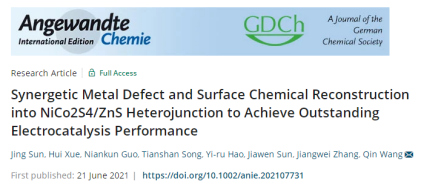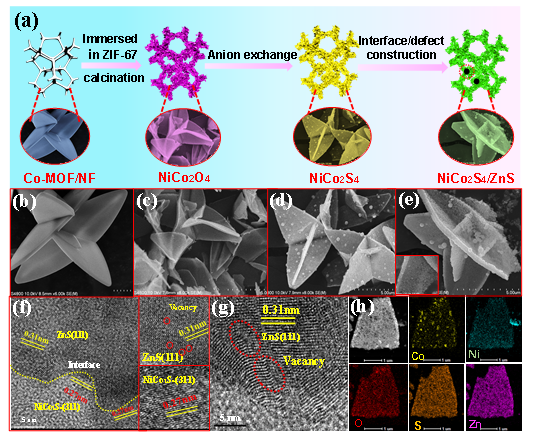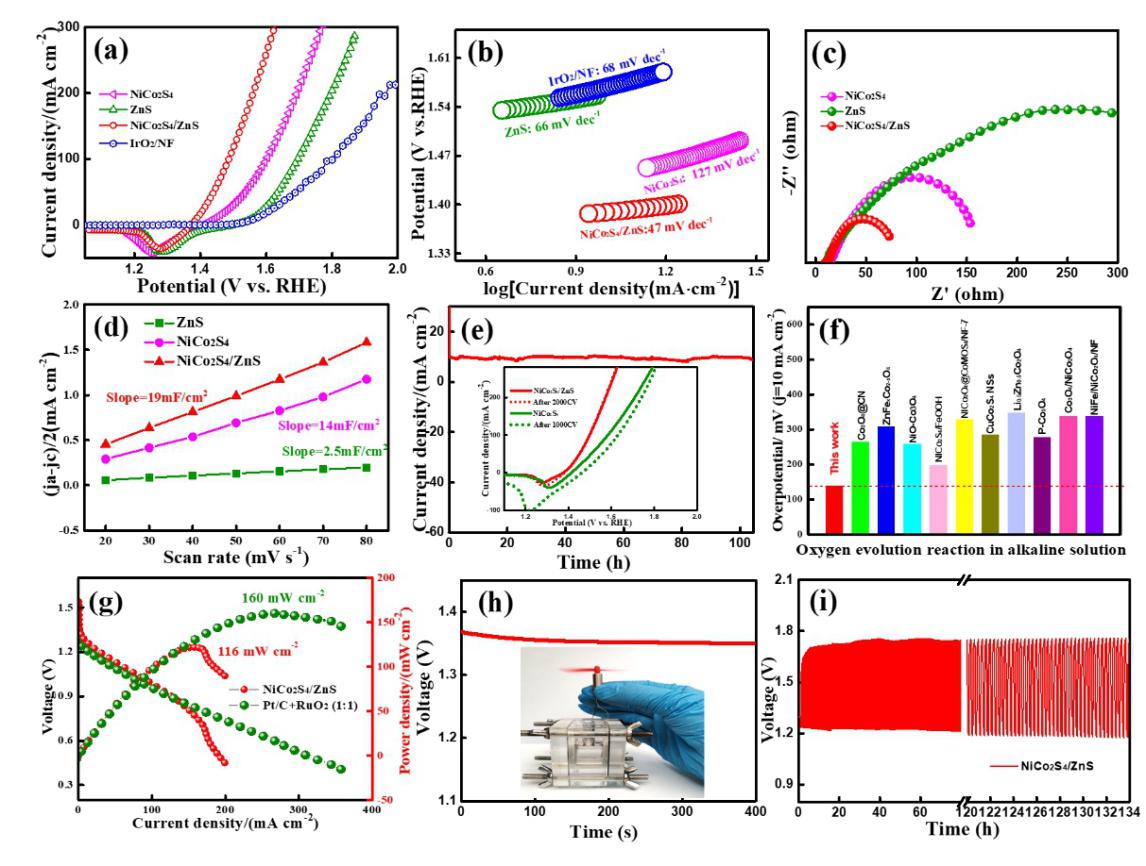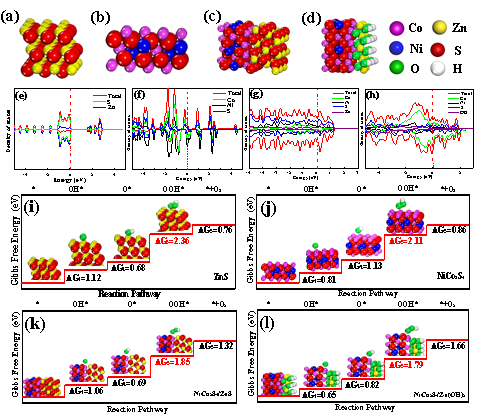Recently the team of Prof. Wang Qin of IMU achieved important progress in their research by publishing a research thesis in Angew. Chem. Int. Ed. entitled Synergetic Metal Defect and Surface Chemical Reconstruction into NiCo2S4/ZnS Heterojunction to Achieve Outstanding Electrocatalysis Performance with IMU as the organization of the first author and the only corresponding author, Sun Jing, a doctoral candidate enrolled in 2019 and Dr. Xue Hui, a young faculty member as the first authors and Prof. Wang Qin as the corresponding author.

Started in 1888, Angewandte Chemie is the official journal of GDCh and is published by Wiley–VCH. As an authoritative journal in the field of chemistry, Angewandte Chemie covers all the areas in chemical research and publishes various contents including news, comprehensive comments, viewpoints, correspondence and research theses.
Oxygen evolution reaction (OER) is an important reaction in new-type electro-chemical energy technologies including water decomposition, fuel batteries and metal-air batteries, etc. However, restricted by reaction energy barriers and dynamic processes, external catalyst materials are needed to accelerate the reactions. Transition metal sulfides are regarded as the new generation high-property electrode catalytic materials for their low cost, open skeleton structure and unique electrochemical properties. However, the low conductivity, excessive changes in size during the electro-catalysis and rapid declining in catalytic activity of sulfides have restricted their commercialized application. In addition, in the environment of high voltage and strong oxidization of OER, electro-chemical restructuring will occur on the surface of metallic sulfides, therefore the determination of the eigen catalytic locus of metallic sulfides turns out to be particularly complicated.
In view of these facts and on the basis of their recent research work (Adv. Energy Mater, 2018, 8, 1800980; Angew. Chem. Int. Ed, 2020, 59, 13778; Small, 2021, 27, 2102125;Chem. Comm, 2021, DOI:10.1039/d1cc02038b;Chem. Eng. J, 2021, 416, 1290980; ACS Appl. Energy Interfaces, 2021, 4, 5339; Appl Catal B-Environ, 2021, 295, 120314), the team of Prof. Wang Qin adopted the strategy of in-situ construction of heterojunction to anchor ZnS nano-particles rich in Zn defects firmly on the surface of NiCo2S4 nano sheets to construct NiCo2S4 structure. The local electro-structure can be effectively adjusted and its electro-catalytic activity can be increased by integrating multi-phase interfaces and metallic defects into single electro-catalytic materials.

A diagram showing the composition, structure, shape and appearance of catalytic materials
The catalytic properties of NiCo2S4 nano sheets decline rapidly as their size fluctuate greatly under the conditions of strong voltage in OER and strong oxidization. The anchoring of ZnS nano particles restrains the expansion of the size of NiCo2S4 nano sheets in the process of electro-chemical recycling and ensures the stability of the compound materials. The construction of hetero interfaces can promote the transfer of electrons, activate built-in field effects, adjust surface binding energy and consequently upgrade catalytic properties. In addition, the construction of Zn defects not only introduces abundant active sites but also forms new synergistic coordinating structures with active matters like hetero atoms to achieve optimal catalytic properties.

The electro catalytic properties of heterojunction materials
Thanks to Zn vacancy defects, surface restructuring and the coordinating effects of heterojunctions, NiCo2S4/ZnS displays excellent OER activity and stability: in the KOH solution of 1.0 M, merely 140 mV of overpotential is needed to reach the electric current density of 10 mA cm², and stability test upon 110 h manifests a property decline of only 5%. Approaches including SEM, AFM, XRD, XRS and EPR are employed to conduct systematic characterization of the materials before and after surface chemical restructuring. The results indicate that the ZnS nano particles on the surface of NiCo2S4/ZnS can be converted into Zn(OH)2 without fixed shape on the same site, and the contents of surface defects further increases. DFT calculation structure indicates that the construction of NiCo2S4 and ZnS hetero interfaces, Zn vacancies and chemical restructuring coordinate the transfer of electric charges between catalysts and intermediates and consequently change the adhesive strength and Gibbs free energy of the reaction, and eventually optimize the catalytic activity of the OER. The research offers a simple strategy for the construction of multi-phased structure abundant in Zn defects and provides references for the interface engineering designing of high-property catalysts.

The dynamics of electric catalytic reaction
A brief introduction to Prof. Wang Qin:
Prof. Wang Qin has been teaching at IMU since July 2010 when he graduated from the major of Physical Chemistry of the College of Chemistry of Jilin University with a doctorate in Sciences. Prof. Wang has been appointed as a corresponding reviewing expert of the National Natural Science Foundation of China, a corresponding reviewing expert of the China Academic Degrees & Graduate Education Development Center of the Ministry of Education of China, a member of the Committee of Biology, Chemistry and Environmental Sciences and members of the editorial boards of numeral major international academic journals. The project team of Prof. Wang Qin take in view the need for major energies of the Autonomous Region and the direction of development of the discipline, conduct distinctive research work on energy chemistry, rare earth and new materials of the Autonomous Region, and have made a series of significant innovative achievements. Prof. Wang is in charge of more than 10 scientific research projects of various categories, including 3 projects sponsored by the National Natural Science Foundation of China, 1 project by the Natural Science Foundation of Inner Mongolia for Major Projects and 1 project by the Foundation of Inner Mongolia for the Cultivation of Outstanding Youths. Prof. Wang has published more than 70 academic theses of high quality as the first author or as the corresponding author in Angew. Chem. Int. Ed, Adv. Energy Mater, Appl Catal B-Environ and other journals, many of which have been selected as cover theses.
URL for the thesis: https://onlinelibrary.wiley.com/doi/epdf/10.1002/anie.202107731
Website of the project team: https://www.x-mol.com/groups/wangqin

